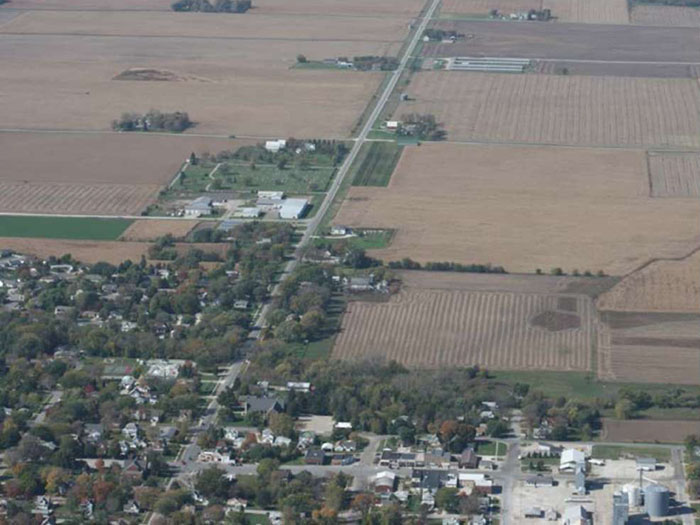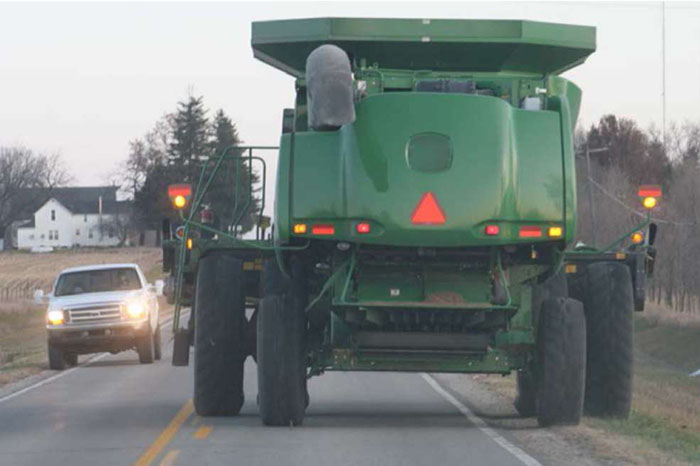U.S. Department of Transportation
Federal Highway Administration
1200 New Jersey Avenue, SE
Washington, DC 20590
202-366-4000
Speeding is a persistent issue faced by all transportation agencies trying to balance mobility and safety in their communities. Rural communities often exist along state highways and county roads with the daily traffic providing both positive economic benefits and potential safety and livability concerns due to speeding.

Figure 1-1 Single vehicle crash into electric pole at rural community entrance
(Image Source: Neal Hawkins)
Seventy five percent of the more than 3,000 counties across the United States are classified as rural, constituting 81 percent of the national land area1. The small communities in these counties generate millions of driving, walking, and biking trips each day. Such trips, particularly for trucks and automobiles, frequently involve entering and exiting town centers, as drivers travel from one small town to the next, or to/from the small town to a larger urban area. The transition from high speeds of 55 MPH or greater in open areas between these small communities, to target speeds oftentimes of 35 MPH or lower within the town centers is a challenge, particularly when vehicles must interact with pedestrians and bicyclists. Nonetheless, maintaining a well-designed and travel space in these transition zones is essential to improving traffic safety and enhancing community livability.

Figure 1-2 – Typical rural community with rural road transitioning into a Main Street environment
(Image Source: Neal Hawkins)
As shown in Figure 1-2, the major roadway through town–Main Street–is often the backbone of a rural community and may be used by bicyclists and pedestrians while visiting local businesses or for general recreation, especially children who may cross the roadway for community activity hubs such as schools, swimming pools, or playgrounds. Without a dedicated and well-signed bypass route, commuters, freight vehicles, and other pass-through traffic can be in direct conflict with these community activities, which is especially dangerous when vehicles enter these town centers at a high rate of speed. At high speeds, drivers are not able to process as much information in their field of view, and pedestrians and bicyclists have a more difficult time judging safe gaps between vehicles. Crashes that do occur may be more severe, especially those that involve vulnerable roadway users, due to longer emergency response times and fewer well-equipped medical facilities.
Given the risks associated with speeding in small communities, particularly those areas adjacent to high/low speed transition zones, it is important that local transportation professionals ensure a safe travel environment for all roadway users. Part of this work includes having resources available to the practitioner to identify areas where speeding is a problem, and implementing design and operational treatments in these areas to eliminate systemic causes of speeding.
The overarching objective of this ePrimer is to support decision-making by transportation professionals when considering the need for speeding countermeasures within small rural and suburban communities and their transition zones from high-speed rural roads. This ePrimer highlights some of the critical issues faced by rural communities when identifying and implementing countermeasures, such as suitability for winter maintenance, or the ability to accommodate large agricultural equipment. It is critical to remember that the applicability of a particular traffic calming measure has as much to do with the speeding problem being addressed as it does the physical and operational context in which the countermeasure is to be implemented.

Figure 1-3 Oversized agricultural vehicle traversing the main roadway through a rural community.
(Image Source: Neal Hawkins)

Figure 1-4 Speeding countermeasures suitable for rural communities.
(Image Source: Neal Hawkins)
This ePrimer can serve as a valuable resource for practitioners in rural communities when developing speed management plans, selecting appropriate speeding countermeasures, and evaluating their effectiveness. The primary audience of the ePrimer is transportation agency professionals who manage or provide guidance to these communities. However, since many rural communities lack a dedicated engineering department or formal transportation staff capabilities, the material contained in this ePrimer is presented in a manner which is applicable to the level of knowledge and decision-making authority possessed by community leaders and local law enforcement officials.
Chapter 1 of this ePrimer contains introductory information meant to familiarize the reader with the rest of the resource. Chapter 2 provides planning considerations for rural communities to address safety issues caused by speeding. Chapter 3 discusses speed and crash study techniques that are applicable to rural communities in both the transition zones and town center/Main Street areas. Chapter 4 provides information and guidance on establishing proper speed transition zones. Chapter 5 discusses speeding countermeasures in terms their appropriateness for different areas within a rural community. Finally, Chapter 6 of the ePrimer lays out four case study jurisdictions with speeding problems, and details their approaches and solutions for speeding and speed management.
The FHWA Traffic Calming ePrimer was also developed by FHWA in partnership with the Institute of Transportation Engineers (ITE) and presents a comprehensive review of traffic calming practices for a variety of urban, suburban, and rural areas. The Traffic Calming ePrimer contains the following:
The Traffic Calming ePrimer covers traffic calming tools and techniques at a broader scale than this ePrimer, and in many cases focuses on treatments suitable for more urban areas. However, much of the background information is also applicable to rural speed management, and as a result, the Speed Management ePrimer for Rural Transition Zones and Town Centers can be thought of as a supplement to that resource. Information that is unique to rural transition zones and town centers is provided in a greater level of detail here than in the Traffic Calming ePrimer. Speeding countermeasures most appropriate to rural contexts are the focus in this ePrimer, and information about countermeasure application or effectiveness that may differ from what is provided in the Traffic Calming ePrimer is especially emphasized. In addition to individual countermeasures, the Speed Management ePrimer for Rural Transition Zones and Town Centers provides a more comprehensive template for developing and implementing a speed management plan in rural communities, which recognizes some of the resource constraints and community dynamics unique to a small town environment.
In many cases, however, information about speed management plan implementation and speeding countermeasures provided in the Traffic Calming ePrimer is directly relevant to rural transition zones and town centers. In those cases, the material is not duplicated in this ePrimer, but appropriate references are made to allow the practitioner to navigate both resources effectively and efficiently.
The following terminology is used frequently throughout the ePrimer, and definitions are provided herein to avoid reader unfamiliarity. Definitions are not provided for terms which are explicitly defined in other parts of the ePrimer, particularly where use of the term is limited to only a few sections.
1 USDOT, Small Town and Rural Multimodal Networks, 2016
2 https://safety.fhwa.dot.gov/speedmgt/ref_mats/fhwasa10001/#c2
3 https://safety.fhwa.dot.gov/tools/data tools/fhwasa1139/
4 www.cmfclearinghouse.org/about.cfm
5 AASHTO Highway Safety Manual, 1st Edition (2010)
6 https://smartgrowthamerica.org/program/national-complete-streets-coalition/what-are-complete-streets/
7 https://safety.fhwa.dot.gov/local_rural/training/fhwasa14072/sec7.cfm
8 https://mutcd.fhwa.dot.gov/
9 https://safety.fhwa.dot.gov/tsp/fhwahep09043/fhwahep09043.pdf
10 https://safety.fhwa.dot.gov/rsa/
11 https://safety.fhwa.dot.gov/speedmgt/datafacts/docs/speeding_rural.pdf
12 https://www.nap.edu/catalog/22890/speed-reduction-techniques-for-rural-high-to-low-speed-transitions
13 https://safety.fhwa.dot.gov/speedmgt/
14 https://safety.fhwa.dot.gov/local_rural/training/fhwasa010413spmgmt/
15 http://ergotmc.gtri.gatech.edu/generic/Glossary/def t003.htm
16 AASHTO Highway Safety Manual, 1st Edition (2010)
| Rural Transition Zones ePrimer | Module 2 >> | |
